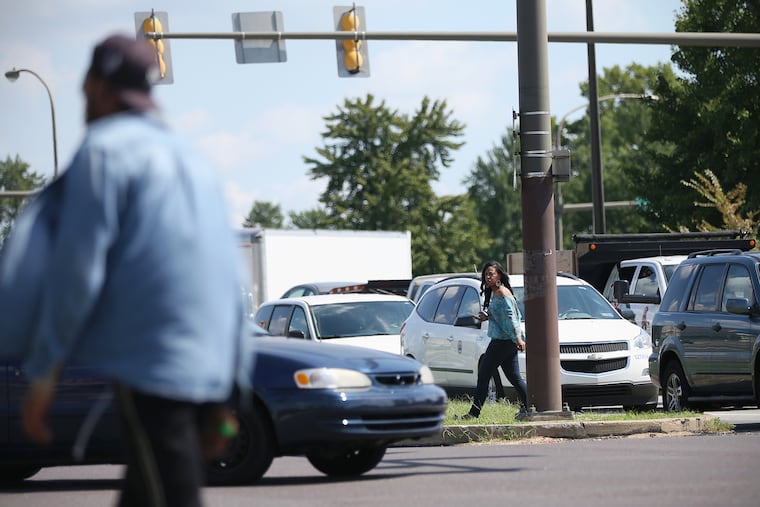Traffic deaths on Roosevelt Blvd. spiked in 2018. A safety fix may not be in place until fall.
The death toll on the road in 2018 appears to be the worst in six years.

Roosevelt Boulevard had one of its deadliest recent years in 2018.
The Boulevard was the scene of 21 fatal crashes last year, according to data released by the Philadelphia Police Department that includes deaths on the limited-access Roosevelt Expressway. One person died in each crash. Of the city’s 96 fatal crashes in 2018, 21 percent happened on the Boulevard.
“What we’ve seen generally is 10 to 13 percent on Roosevelt Boulevard,” said Randy LoBasso, a spokesman for the Bicycle Coalition of Greater Philadelphia. “If we’re seeing 20 to 21 percent, that’s really bad.”
In October, Pennsylvania’s legislature approved the use of speed cameras, which officials say could make the road safer. But putting the cameras in place requires City Council approval, and a bill to make that happen has yet to be introduced, as city officials work out how the cameras will be used.
The data released by the police are not the final count of deaths on the Boulevard, said Mike Carroll, the city’s deputy managing director of the Office of Transportation, Infrastructure, and Sustainability (OTIS). The official count will come from PennDot months from now, and the state may have more precise locations or may not include crashes that followed criminal activity, he said. Still, it is likely 2018 will stand as the most deadly year in recent history.
The death toll reported by police was more than twice as high as 2017′s. And seven more people died last year than in 2015, which with 14 deaths in 13 crashes had been the most deadly in the last five years, according to PennDot. Citywide, 101 people died on the roads in 2018, according to police data. PennDot recorded 94 deaths in 2017.
The 12-lane thoroughfare runs through dense residential and business development. Traffic that often far exceeds the 45 mph speed limit vies with crossing pedestrians and vehicles pulling onto the road from side streets. Ten of those killed last year were pedestrians. Carroll wasn’t prepared to say why the past year was so bad without more information but noted that crashes are up nationally, which in part is likely due to lower gas prices and a more healthy economy.
The road is a top priority in Philadelphia’s efforts to reduce traffic deaths. A $5 million study is reviewing ways the Boulevard can be made safer. The road probably needs changes to the timing on signals and redesigning some intersections, but engineering changes could take years to complete. Meanwhile, traffic there, already close to 90,000 vehicles a day, is expected to increase 4 percent in the next seven years.
City officials and safe streets advocates called state approval of speed cameras a significant win that could improve safety quickly, and the Philadelphia Parking Authority, which will oversee the program, has issued a request for proposals to provide equipment and manage the cameras.
Council members said they are waiting for recommendations from the city, aides said. OTIS has not made public where it wants to place the cameras, Carroll said, and likely won’t ask Council to vote on specific locations, to leave leeway for changes. The city has anticipated placing cameras at nine intersections.
There is discussion about where to place signs warning motorists of the presence of cameras, which the state legislation mandated. And there are questions about how many tickets a speeding driver should get if that person triggers multiple cameras in a short period.
“I think the default setting is, if you trigger 10 cameras, then you’re subject to 10 citations,” Carrollsaid.
The legislation last year passed legalized speed cameras on the Boulevard between Ninth Street and the border with Bucks County, as well as in work zones on state highways and the Pennsylvania Turnpike.
Carroll anticipated the cameras could be operating in the fall. Drivers will have a 30-day grace period during which speeders would receive a warning. Once penalties go into effect, anyone photographed traveling 11 mph over the 45 mph speed limit would receive a $150 violation notice.
Half the revenue from the Boulevard cameras will go toward transportation projects in Philadelphia. The rest will go toward state projects.
Carroll anticipated legislation being introduced in Council in a matter of weeks. When the cameras are in place, though, the effect on drivers' behavior may not be immediate.
“We’ll probably know the effects of this within a year of them being installed,” LoBasso said. “Any time there’s an immediate change to a street, you don’t always see an immediate positive reaction.”